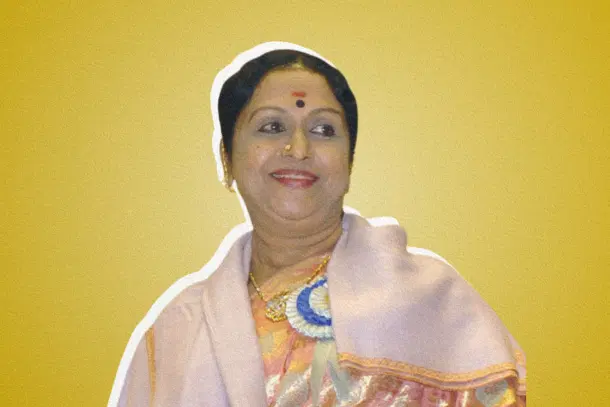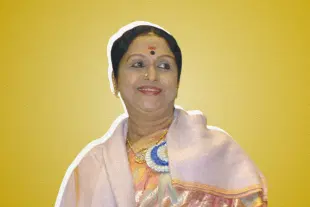Obit
A Smile That Stayed: Remembering Saroja Devi
K Balakumar
Jul 14, 2025, 03:21 PM | Updated 03:43 PM IST
Save & read from anywhere!
Bookmark stories for easy access on any device or the Swarajya app.


In the long, glittering arc of Tamil cinema, a soft light has gone out. B. Saroja Devi, the endearing Kannadathu Paingili, who shared screens with giants like MGR, Sivaji Ganesan, NTR and Rajkumar, passed away in Bengaluru today at the age of 87. With her, a chapter of South Indian film history, which was charming and melodic, has come to a close.
Saroja Devi was never the most dazzling dancer like Padmini, nor the most emotive actor like Savithri. Yet she was unmistakably a star. At her peak in the 1960s, few names shone brighter across South India’s cinematic landscape. Her films, that funny voice and dialogue delivery, and graceful presence, lingered in the minds of audiences long after the credits rolled. She became that rare thing in film, a consistent presence that did not overwhelm, but always assured.
What truly set Saroja Devi apart was her ability to remain a top-tier star for decades without necessarily possessing the profound acting prowess or the conventional beauty queen allure. She commanded attention through her natural effervescence, her expressive eyes, and an undeniable charisma that transcended traditional metrics of stardom.
First ever screen style diva
Further, before social media turned every starlet into a style influencer, before glossy magazines dissected saree drapes and blouse cuts, Saroja Devi had already set the template for screen fashion. With her puffed-sleeve blouses, high necks, and ever-graceful hairdos, she was Tamil cinema’s first bona fide style diva, when the word had not yet been invented.
Her sartorial choices, always elegant, left an indelible mark on the wardrobes of an entire generation of women who saw in her a blend of modernity and modesty. For the young Tamil girl of the 1960s, mimicking Saroja Devi’s look was not just admiration, it was aspiration.
Born in Bengaluru in 1938 to a conservative Kannada family, Saroja Devi’s early ambitions had little to do with cinema. Her father, a police officer, was supportive of the arts, and encouraged her to learn dance. But when she was offered her first film role in Kannada, he resisted. It was only after persistent persuasion that he relented, and the girl who would become a household name took her first steps into cinema through the Kannada film Mahakavi Kalidasa (1955).
While Kannada cinema gave her entry, it was Tamil cinema that made her immortal. Legendary director B. R. Panthulu introduced her to Tamil audiences through Thangamalai Ragasiyam (1957). But it was M. G. Ramachandran’s Nadodi Mannan (1958) that changed everything.
The leading lady of MGR, Sivaji era
Cast opposite MGR, Saroja Devi began an extraordinary run of 26 hits with him. She was not just a co-star, she became part of his onscreen aura, bringing sweetness and sparkle to his stern, moralistic persona.
In their most successful outing Anbe Vaa (1966), set unusually in a modern, affluent world, Saroja Devi matched MGR’s larger-than-life image with vivacity. In Enga Veettu Pillai (1965), she brought mischief to a story of mistaken identities. Her roles were often those of romantic foils, women with gentle defiance, quick wit, and an old-world grace.
Their on-screen chemistry was effortless and magnetic, contributing significantly to the success of movies like Panakkara Kudumbam (1964), Padagotti (1964), Thirudathe (1961), Thaai Sollai Thattadhe (1961), Panathottam (1963), Periya Idathu Penn (1963), Thayai Katha Thanayan (1963), Dharmam Thalai Kaakkum (1963), Needhikkuppin Paasam (1963), Dheiva Thaai (1964), Nadodi (1966), Naan Aanaiyittal (1966), Petralthan Pillaiya (1966), Parakkum Paavai (1966) and Arasa Kattalai (1967).
While MGR films showcased her bubbly side, movies with Sivaji, with whom she did 22 movies, often allowed her to explore roles with more emotional depth, albeit still within her characteristic but limited style. In Puthiya Paravai (1964), their milestone movie together, she played a woman caught in a psychological mystery, offering a nuanced counterpoint to Sivaji’s haunted protagonist.
In Vidivelli (1960) and Kulamagal Radhai (1963), she anchored roles that demanded both grace and inner strength. Films like Sabaash Meena (1958), Paalum Pazhamum (1961), Paarthaal Pasi Theerum (1962), Iruvar Ullam (1963), Aalayamani (1962) and Bhaaga Pirivinai (1959) demonstrated her versatility in adapting to Sivaji’s intense acting style. Her ability to switch between light-hearted romantic roles and more serious, emotionally charged characters, all while maintaining her distinctive screen presence, was a testament to her innate talent.
With Gemini Ganesan, the third big star of those times in Tamil, she did 17 movies, including that legendary love tragedy Kalyana Parisu (1959). Her Tamil diction, affectedly melodious but clearly non-native, was initially ridiculed for its childlike lilt. Yet audiences grew fond of it. In an industry that often demands perfection in language and dialect, Saroja Devi’s unique cadence became her charm.
Pan-Indian appeal
Beyond Tamil, Saroja Devi graced the screens in Kannada, Telugu, and Hindi cinema, proving her pan-Indian appeal. Overall, she acted in close to 200 films across Kannada, Tamil, Telugu, and Hindi, often as the lead heroine.
In Telugu, she played Mandodari to N. T. Rama Rao’s Rama in Seetarama Kalyanam (1961). She was also paired opposite him in blockbusters like Jagadeka Veeruni Katha (1961) and Daagudu Moothalu (1964). In Hindi, she starred in Paigham (1959) opposite Dilip Kumar, Sasural (1961) with Rajendra Kumar and in Pyaar Kiya To Darna Kya (1963) with Shammi Kapoor. No small feat for a southern actress in the 1960s.
She was hailed as the first female superstar of Kannada films, and her nickname in Tamil Kannadathu Paingili reflected both her linguistic identity and her delicate screen persona. Her early Kannada hits included School Master (1958), Kittur Chennamma (1961), and Amarashilpi Jakanachari (1963), the first Kannada movie to be fully shot in colour. She later worked with Dr. Rajkumar in several successful films, including Mallammana Pavada (1969) and Babruvahana (1977).
Her fluency in multiple languages and camera-friendliness made her a director’s delight. In an industry often segregated by linguistic boundaries, Saroja Devi moved with ease, no fanfare, just quiet determination. To have been the leading lady in 161 films between 1955 and 1984 is a feat unmatched in Indian cinema.
Muse for music and lyricists
In the golden age of Tamil cinema, when music was lyrical, colours were soft, and romance was still innocent, Saroja Devi danced gently through its most beloved frames. She was the on-screen muse for some of Tamil cinema’s most iconic songs, melodies that have endured across generations.
To say she starred in Tamil hits would be an understatement. She was the face on whom composers composed, lyricists dreamt, and playback singers soared. In Anbe Vaa, she lit up the screen for the exuberant MGR number Naan Paarthathilae, a flirtatious fun number amidst the hills and green. In Padagotti, her face carried the breezy charm of the rhythmic Thottal Poo Malarum, where T. M. Soundararajan and P. Susheela sang of love blooming with a touch. Or consider Periya Idathu Penn, where MGR and she in that waltzy Andru Vandhathum Adhe Nila are an epitome of style and panache.
She embodied not just love songs, but also ones that framed ideals, identity, or playfulness. Her expressions in Vadikkai Maranthathum (Kalyana Parisu), is a testament to that. But the song that verily encapsulates Saroja Devi's on-screen persona of that era is decidedly Unnai Ondru Ketpen in Puthiya Paravai. Style, impishness and romance radiate through that chartbuster for ages. Aalaya Maniyin Osaiyai in Paalum Pazhamum had a kind of emotional literacy that required no formal acting brilliance, just sincerity.
Saroja Devi did not just act in these songs, she completed them. Her presence gave visual poetry to Kannadasan’s metaphors, Vaali’s playful phrasing, and M. S. Viswanathan’s elegant melodies. There was something in her screen persona, vivacious but never loud, pretty but never overpowering, that made her the perfect heroine for romantic odes and soulful ballads. These songs were not about spectacle but about emotion, innocence, and melodic narrative.
A well recognised performer
Her illustrious career was adorned with numerous accolades. She was honoured with the Padma Shri in 1992 and the Padma Bhushan in 2002, recognising her immense contributions to Indian cinema. She also received the Karnataka Rajya Prashasti, the NTR National Award, and several Filmfare Awards South, among many others, acknowledging her enduring impact and artistic excellence.
In her later years, Saroja Devi gracefully transitioned to character roles. Her appearance in films like the 2009 Tamil hit Aadhavan, where she played the grandmother, was met with warmth and appreciation, proving that her appeal remained undiminished. She continued to be a revered figure, a living legend who inspired generations of actors.
Behind the screen shimmer, Saroja Devi led a life marked by grace and tragedy. She married engineer Sri Harsha in 1967 and slowly reduced her screen appearances to focus on family. The couple had an adopted daughter, but heartbreak followed. Her husband died in 1986, and her daughter passed away young. Yet she remained remarkably composed in public, seldom courting sympathy, always retaining her dignity.
Graceful till the end
In the end, Saroja Devi's real triumph was not in a singular performance or a shelf of awards, but in her consistency. At a time when female stars often had short shelf lives, she stayed relevant for over six decades. She worked with three generations of actors, from MGR to Suriya, and navigated the changing tides of cinema with grace. Her death marks not just the end of a career, but the fading of a cinematic style, where heroines were demure, songs were poetic, and love was always larger than life.
Saroja Devi may not feature in critical essays on acting brilliance. She may not top dance compilations or win retrospectives for her range. But she will forever be remembered as the smiling, soft-spoken, steadfast heroine of Tamil cinema’s golden age.
In the final reckoning, that too is greatness, of a quieter kind.





